WBBSE Chapter 2 Determination Of The Location Of A Place On The Earths Surface Topic A Parallels Of Latitude Long Question And Answers
Question 1. Describe the important parallels of latitude.
Answer:
Important parallels of latitude:
The important parallels of latitude present in either hemisphere are designated with individual names because of their importance. Some of these important parallels of latitude are described below-
1. Equator (0°):
The east-west line that runs around the middle of the Earth is called the Equator. The northern half of the Earth as divided by the Equator is called the northern hemisphere and the southern half is known as the southern hemisphere.
2. Tropics of Cancer (23½°N):
The 23½° north latitude is known as the Tropic of Cancer. It marks the northern limit of the apparent movement of the Sun.
3. Tropics of Capricorn (23½°S):
The 23½° south latitude is known as the Tropic of Capricorn. It marks the southern limit of the apparent movement of the Sun.
Read And Learn Also WBBSE Solutions For Class 7 Geography
4. Arctic Circle (66½°N):
The 66½° north latitude is known as the Arctic Circle. The area between the Arctic Circle and the North Pole experiences 24 hours of daylight from 21 June of every year for six months.
5. Antarctic Circle (66½°S):
The 66½° south latitude is known as the Antarctic Circle. The area between the Antarctic Circle and the South Pole experiences 24 hours of daylight from 22 December of every year for six months.
6. North Pole (90° N):
The 90° north latitude is known as the North Pole. The location of the North Pole is determined by the North Star.
7. South Pole (90° S):
The 90° south latitude is known as the South Pole. The location of the South Pole is determined by Hadley’s Octant.

Question 2. Mention the types of latitude.
Answer:
Different types of latitudes are-
1. Northern latitudes:
Latitudes located due north of the Equator are called the northern latitudes. These are denoted by the letter ‘N’.
2. Southern latitudes:
Latitudes located due south of the Equator are called southern latitudes. These are denoted by the letter ‘S’.
3. Low, middle, and high latitudes:
The parallels within 30° north and south of the Equator are called low latitudes. The parallels within 30°-60° north and south of the Equator are called middle latitudes and those of 60° north and south of the Equator are called high latitudes.
Question 3. Define the Equator. What are the characteristics of the Equator?
Answer:
Equator:
The imaginary line encircling the Earth equidistant from the two Poles and dividing the Earth into two equal halves-the northern and the southern hemispheres is known as the Equator.
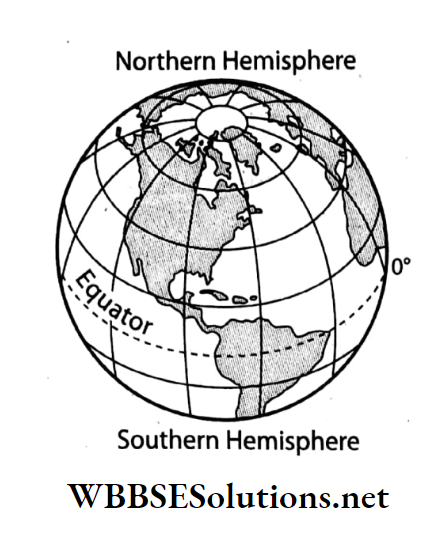
The main characteristics of the Equator are-
- The Equator has an angular measure of 0°.
- It is the only great circle on Earth.
- Throughout the year, sunrays fall vertically over the Equator.
- The Equator divides the Earth in two hemispheres-northern and southern hemispheres.
- The center of the Equator and the center of the Earth is the same.
Question 4. Name the important parallels of latitude.
Answer:
Important parallels of latitude:
Among all the parallels, there are certain parallels in each of the hemispheres that are considered important as they help us to divide the Earth into different zones. These are-
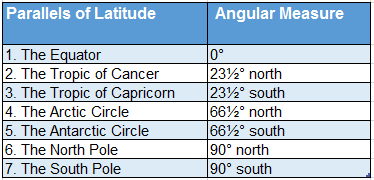
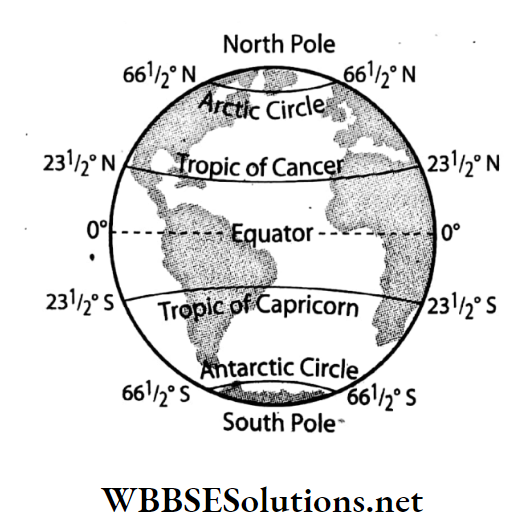
Question 5. What are the important characteristics of parallels of latitude?
Answer:
The important characteristics of parallels of latitude are-
1. Orientation:
The parallels of latitude run in an east-west direction. The Equator is the most important latitude and its value is 0.
2. Shape:
Except for the two Poles, all the parallels of latitude are complete circles and parallel to one another.
3. Circumference:
The circumferences of the parallels of latitude gradually decrease as one moves away from the Equator toward the Poles.
4. Angular measurement:
The sum total of the angular measures of each parallel of latitude is 360° (except the two Poles).
Question 6. How can we determine the latitude of a place on the Earth’s surface?
Answer:
To determine the latitude of a place on the surface, for example, point A on Earth, we have to draw a line \((\overrightarrow{A O})\) from the mentioned point (A) to the center of the Earth (O).
Then, we have to draw another line \((\overrightarrow{O B})\) from the intersection (of the meridian and the Equator) point (B), to the Earth’s center (O). The angle ∠AOB formed by these two lines is the latitude of point A.
According to the diagram, the angular distance of the parallel is 55° and as it is located due North of the Equator, it is denoted as 55°N.
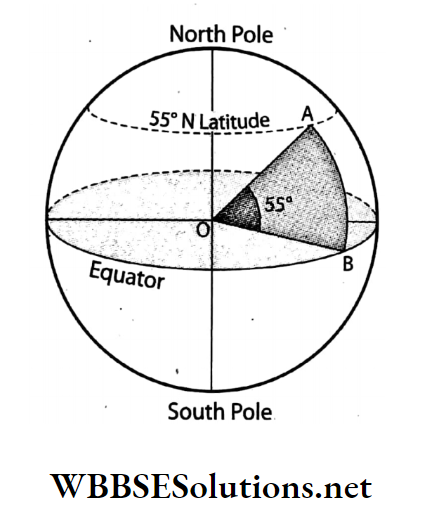
Question 7. Why is the Equator important?
Answer:
The Equator is important because of the following reasons-
1. Determining the hemispheres:
The Equator being equidistant from the North Pole and the South Pole divides our Earth into two equal halves-the northern hemispheres and the southern hemisphere.
2. Determining a location:
The location of a place in any of the two hemispheres is determined by its angular distance north or south of the Equator.
3. Determining the length of day and night:
The Circle of Illumination bisects the Equator at an angle of 90°. As a result, all the places located on this line experience equal lengths of day and night throughout the year.
By determining the Sun’s angle of incidence, weather, pressure zones, heat zones, and precipitation zones can be defined. So, the Equator is a very important parallel.
Question 8. State the difference between latitude and parallel of latitude.
Answer:
The difference between latitude and parallel of latitude are-
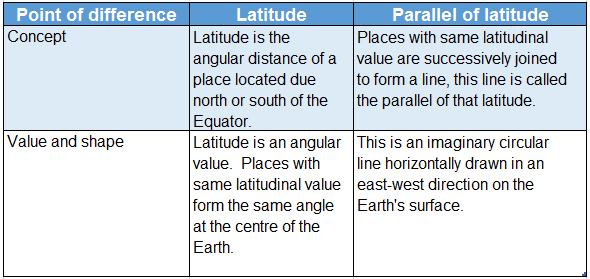
Question 9. State the importance of the parallels of latitude.
Answer:
The importance of the parallels of latitude are-
1. Determining the location of a place:
The location of a place is determined by its angular distance north or south of the Equator as measured from the Earth’s center. As we move north or south of the Equator, the angular distance increases.
2. Determining the extent of heat zones:
The Earth can be divided into three heat zones on the basis of the amount of heat received from the Sun over the parallels. These are torrid, temperate, and frigid zones.
3. Determining the climate of a place:
The climate of a place can be determined from the latitudinal position of that place on the Earth’s surface. Higher the latitudinal position, the colder the climate, and vice versa.
Question 10. What is the relation between the parallels of latitude and the climate?
Answer:
Throughout the year the Sun’s rays fall vertically over the Equator and regions near it. Away from the Equator towards the Poles the vertical rays of the Sun tend to become more and more oblique.
Direct rays give more heat than slanted rays. As a result, there is a gradual decrease in the average temperature towards the Poles.

Question 11. What is the equatorial plane?
Answer:
Equatorial plane:
The plane passing through the Equator of the Earth is known as the equatorial plane. It runs midway between the Poles perpendicular to the Earth’s axis.
If the Earth is cut from the Equator, then we can see the equatorial plane shown in the diagram.
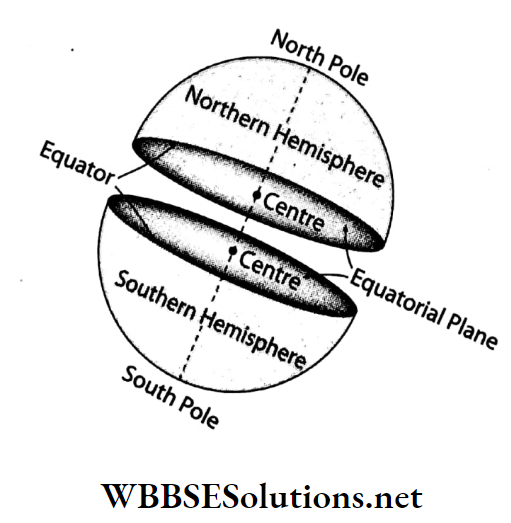
Question 12. What are the parallels of latitude?
Answer:
Parallels of latitude:
Parallels of latitude are imaginary circular lines drawn horizontally between the two Poles running in the east-west direction.
- The Equator is a parallel of latitude that runs exactly midway between the two Poles.
- Each parallel of latitude has a specific angular measure.
- 89 parallels of latitude can be drawn in each of the hemispheres at an interval of 1°.
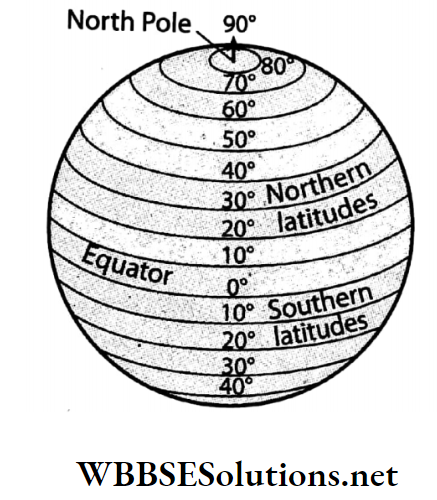
WBBSE Chapter 2 Determination Of The Location Of A Place On The Earths Surface Topic A Parallels Of Latitude Short Question And Answers
Question 1. Define high, middle, and low latitudes.
Answer:
High, middle, and low latitudes:
- On the Earth’s surface, the angular measure of the latitudes ranges from 0° to 90°. In both hemispheres, the parallels having an angular measure of 0° to 30° are termed as low latitudes.
- The parallels having an angular measure of 30° to 60° are termed as middle latitudes and those beyond 60° are termed as high latitudes.
Question 2. How do we calculate the location of a place situated between two parallels? Or, How can you determine the location of a place between two parallels?
Answer:
- Let us take two parallels, 10°N and 11°N. Difference between the two parallels = (11° 10°) 1° = 60 minutes.
- The latitude of a place in between the two parallels = 10° N + 60/2 minutes= 10°30’N
- Or, 11° N- 60/2 minutes= 10°30’N
- Therefore, a place in between 10°N and 11°N will be located at 10°30′ north of the Equator.
Question 3. Why is the Equator called ‘a great circle’?
Answer:
- Any imaginary circle that surrounds the center of the Earth and divides the planet into two hemispheres is called the great circle.
- The equator being an imaginary circular line equidistant from the two Poles, dividing the Earth into two halves
- The northern and the southern hemispheres is the only parallel of latitude with its center coinciding with that of the Earth.
- On the other hand, the center of all other parallels is located on the Earth’s axis and not at the center of the Earth. Therefore, only the Equator is called a great circle among all the parallels.
Question 4. Define the Tropic of Cancer and the Tropic of Capricorn.
Answer:
- The imaginary circular line drawn at an angular distance of 23½° north of the Equator is known as the Tropic of Cancer. It marks the northern limit of the vertical sun rays.
- On the other hand, the imaginary circular line drawn at an angular distance of 23½° south of the Equator is known as the Tropic of Capricorn. It marks the southern limit of the vertical sun rays.
Question 5. Define the Arctic and the Antarctic Circles.
Answer:
The Arctic and the Antarctic Circles:
- The Arctic Circle is the parallel of latitude that runs 66½° north of the Equator, whereas, the Antarctic Circle is the parallel of latitude that runs 661⁄2 south of the Equator.
- The regions beyond the Arctic and the Antarctic Circles experience 6 months of complete daylight and 6 months of complete darkness throughout the year.
Question 6. Define the North and the South Poles.
Answer:
The North and the South Poles:
- The North and the South Poles are not parallels but points on the northern and southern hemispheres where the Earth’s axis of rotation meets its surface.
- It has an angular measure of 90°. The South Pole lies on a continental landmass and the North Pole is located in the middle of the Arctic Ocean.
Question 7. The places located on a particular parallel of latitude do not experience sunrise and sunset at the same time. Or, Do you experience day and night at the same time on the same parallel? If not, why?
Answer:
- Places located on a particular parallel of latitude do not experience day and night at the same time because the parallels of latitude on the surface of the Earth run in an east-west direction.
- As our Earth rotates from west to east, the places on a particular parallel located due east experience sunrise way ahead of the places located due west.
Question 8. What changes do you observe as you move toward the Poles from the Equator?
Answer:
As we move towards higher latitudes i.e. from the Equator towards the Poles, the following are observed-
- Sunrays become oblique i.e. striking the Earth’s surface at a wider angle.
- A gradual decrease in average temperature.
- A change in the characteristics of flora and fauna.
Question 9. What do you mean by linear distance?
Answer:
Linear distance:
- The straight distance between two defined places on a plain surface is known as linear distance.
- This distance is expressed in the units of inches, feet, gauge, miles, meters or kilometers, etc.
Question 10. What do you mean by angular distance?
Answer:
Angular distance:
If two straight lines are drawn from any two points on a spherical surface to the center of the sphere, then the size of the angle formed between the lines at an angular distance the center is known as their angular distance.

Question 11. “The latitude of Kolkata is 22°34′ north”- Explain.
Answer:
“The latitude of Kolkata is 22°34′ north”
- The latitude of a place is its angular distance north or south of the Equator as measured from the center of the Earth.
- The angular distance of Kolkata concerning the Equator is 22°34′ N i.e., it is located in the northern hemisphere. So the latitude of Kolkata is 22°34′ N.
WBBSE Chapter 2 Determination Of The Location Of A Place On The Earths Surface Topic A Parallels Of Latitude Very Short Question And Answers
Question 1. What do we call the angular distance of a place north and south of the Equator?
Answer: Latitude.
Question 2. What are the lines of latitude also known as?
Answer: Parallels.
Question 3. What do we call the imaginary circular line on the Earth’s surface that is equidistant from the two Poles?
Answer: The Equator.
Question 4. What is the 23½° parallel line in the northern hemisphere known as?
Answer: The Tropic of Cancer.
Question 5. What is the 23½° parallel line in the southern hemisphere known as?
Answer: The Tropic of Capricorn.
Question 6. What is the 66½° parallel line in the northern hemisphere known as?
Answer: The Arctic Circle.
Question 7. What is the 66½° parallel line in the southern hemisphere known as?
Answer: The Antarctic Circle.
Question 8. What is the 90° latitude in the northern hemisphere known as?
Answer: The North Pole.
Question 9. What is the 90° latitude in the southern hemisphere known as?
Answer: The South Pole.
Question 10. Places on which line of latitude experience equal lengths of day and night?
Answer: The Equator.
Question 11. What do we call the imaginary plane that passes through the Equator and is perpendicular to its axis?
Answer: The Equatorial plane.
WBBSE Chapter 2 Determination Of The Location Of A Place On The Earths Surface Topic A Parallels Of Latitude Fill In The Blanks
Question 1. The _______________ divides the Earth into two equal halves, the northern and the southern hemispheres.
Answer: Equator
Question 2. The location of a place on the spherical surface of the Earth is determined with the help of its _______________ distance.
Answer: Angular
Question 3. The minimum angular measure of latitude is _______________ degree.
Answer: 0
Question 4. The angular measure of latitudes begins from _______________ degrees.
Answer: 0
Question 5. The angular measure of latitudes extends up to _______________ degrees.
Answer: 90
Question 6. The Earth being a full circle has an angular measure of _______________.
Answer: 360°
Question 7. The imaginary circles drawn parallel to the Equator are known as _______________.
Answer: parallels of latitude
Question 8. _______________ are complete circles.
Answer: Parallels
Question 9. The parallels run in an _______________ direction.
Answer: East-west
Question 10. The _______________ is the longest parallel.
Answer: Equator
Question 11. All the latitudes are _______________ to one another.
Answer: Parallel
Question 12. Although the latitudes are parallel to one another, their circumferences are _______________.
Answer: Unequal
Question 13. The latitude located at _______________ of the Equator is referred to as the Tropic of Cancer.
Answer: 23½° N
Question 14. _______________ latitude passes through Kolkata.
Answer: 22°34′ N
Question 15. The northernmost latitude in the northern hemisphere which is a point is known as _______________.
Answer: North Pole
Question 16. In both the hemispheres, the region within 30° north and south of the Equator is referred to as the _______________.
Answer: Low latitude region
Question 17. The position of _______________ is used for determining the latitude of a place in the southern hemisphere.
Answer: Hadley’s Octant
Question 18. A change in the _______________ is observed as one walks away from the Equator, towards the Poles.
Answer: Climate
Question 19. Each and every place located within 23½°N and 23½°S latitudes experiences _______________sunrays twice a year.
Answer: Vertical
Question 20. The average linear distance between any two parallels at an interval of 1° is approximate _______________.
Answer: 111 Km
WBBSE Chapter 2 Determination Of The Location Of A Place On The Earths Surface Topic A Parallels Of Latitude True Or False
Question 1. The distance between any two parallels is constant throughout the globe.
Answer: True
Question 2. The 90° parallel is called the Equator.
Answer: False
Question 3. The Equator is also known as the Prime Meridian.
Answer: False
Question 4. Parallels are complete circles.
Answer: True
Question 5. The two Poles on the Earth’s surface are actually two points.
Answer: True
Question 6. The radius of the parallels are equal throughout the globe.
Answer: False
Question 7. The average distance between any two parallels is about 110.5 km.
Answer: False
Question 8. Angular distance is also known as linear distance.
Answer: False
Question 9. A sum total of the angular measures of all the parallels is 180°.
Answer: False
Question 10. The region beyond 60° north and south of the Equator is referred to as the region of high latitudes.
Answer: True
Question 11. The region on the Earth’s surface between 30°-60° north and south of the Equator is referred to as the region of low latitudes.
Answer: False
Question 12. The Pole Star is located at 90° south of the Equator.
Answer: False
Question 13. An example of a great circle is the Prime Meridian.
Answer: False
Question 14. The sun rays fall obliquely over the equatorial region.
Answer: False
Question 15. The north-south extension of any place on the Earth’s surface can be determined with the help of meridians.
Answer: False
Question 16. The latitude of a place in the southern hemisphere is determined with the help of the position of the Pole Star.
Answer: False
Question 17. The angular measure of the Equator is 0°.
Answer: True
Question 18. The Antarctic Circle is located in the northern hemisphere.
Answer: False
WBBSE Chapter 2 Determination Of The Location Of A Place On The Earths Surface Topic A Parallels Of Latitude Match The Columns
Question 1.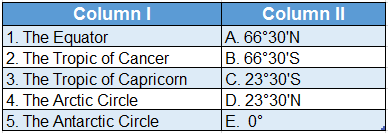
Answer: 1. E, 2. D, 3. C, 4. A, 5. B
